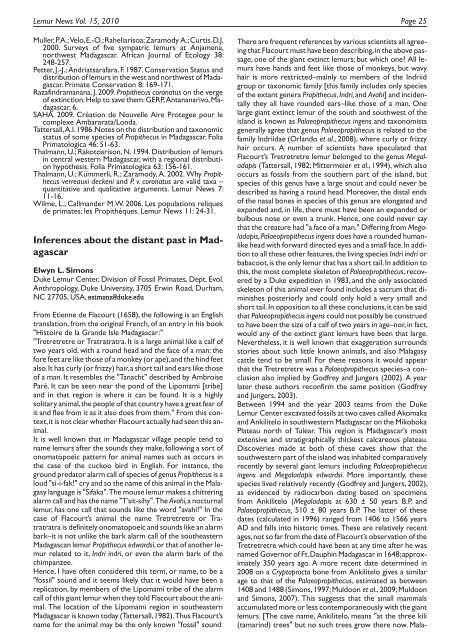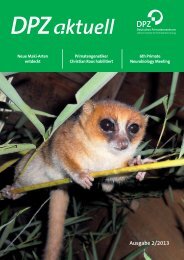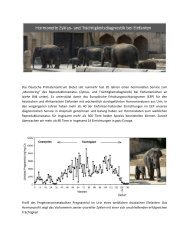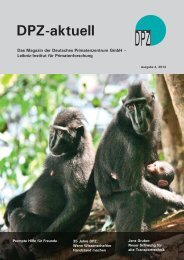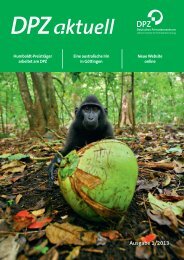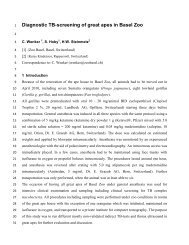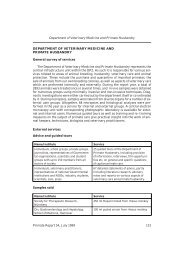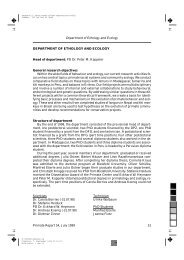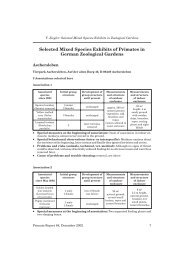Vol. 15 - Deutsches Primatenzentrum
Vol. 15 - Deutsches Primatenzentrum
Vol. 15 - Deutsches Primatenzentrum
You also want an ePaper? Increase the reach of your titles
YUMPU automatically turns print PDFs into web optimized ePapers that Google loves.
Lemur News <strong>Vol</strong>. <strong>15</strong>, 2010 Page 25<br />
Muller,P.A.;Velo,E.-O.;Raheliarisoa;Zaramody A.;Curtis.D.J.<br />
2000. Surveys of five sympatric lemurs at Anjamena,<br />
northwest Madagascar. African Journal of Ecology 38:<br />
248-257.<br />
Petter, J.-J.; Andriatsarafara. F. 1987. Conservation Status and<br />
distribution of lemurs in the west and northwest of Madagascar.<br />
Primate Conservation 8: 169-171.<br />
Razafindramanana, J. 2009. Propithecus coronatus on the verge<br />
of extinction:Help to save them:GERP,Antananarivo,Madagascar,<br />
6.<br />
SAHA. 2009. Crèation de Nouvelle Aire Protegee pour le<br />
complexe Ambararata/Londa.<br />
Tattersall,A.I.1986.Notes on the distribution and taxonomic<br />
status of some species of Propithecus in Madagascar. Folia<br />
Primatologica 46: 51-63.<br />
Thalmann, U.; Rakotoarison, N. 1994. Distribution of lemurs<br />
in central western Madagascar, with a regional distribution<br />
hypothesis. Folia Primatologica 63: <strong>15</strong>6-161.<br />
Thalmann, U.; Kümmerli, R.; Zaramody, A. 2002. Why Propithecus<br />
verreauxi deckeni and P. v. coronatus are valid taxa –<br />
quantitative and qualitative arguments. Lemur News 7:<br />
11-16.<br />
Wilme, L.; Callmander M.W. 2006. Les populations reliques<br />
de primates: les Propithèques. Lemur News 11: 24-31.<br />
Inferences about the distant past in Madagascar<br />
Elwyn L. Simons<br />
Duke Lemur Center, Division of Fossil Primates, Dept. Evol.<br />
Anthropology, Duke University, 3705 Erwin Road, Durham,<br />
NC 27705, USA, esimons@duke.edu<br />
From Etienne de Flacourt (1658), the following is an English<br />
translation, from the original French, of an entry in his book<br />
"Histoire de la Grande Isle Madagascar:"<br />
"Tretretretre or Tratratratra. It is a large animal like a calf of<br />
two years old, with a round head and the face of a man: the<br />
fore feet are like those of a monkey (or ape),and the hind feet<br />
also.It has curly (or frizzy) hair,a short tail and ears like those<br />
of a man. It resembles the "Tanacht" described by Ambroise<br />
Paré. It can be seen near the pond of the Lipomami [tribe]<br />
and in that region is where it can be found. It is a highly<br />
solitary animal,the people of that country have a great fear of<br />
it and flee from it as it also does from them." From this context,it<br />
is not clear whether Flacourt actually had seen this animal.<br />
It is well known that in Madagascar village people tend to<br />
name lemurs after the sounds they make, following a sort of<br />
onomatopoeic pattern for animal names such as occurs in<br />
the case of the cuckoo bird in English. For instance, the<br />
ground predator alarm call of species of genus Propithecus is a<br />
loud "si-i-fak!" cry and so the name of this animal in the Malagasy<br />
language is "Sifaka".The mouse lemur makes a chittering<br />
alarm call and has the name "T’sit-sihy".The Avahi,a nocturnal<br />
lemur, has one call that sounds like the word "avahi!" In the<br />
case of Flacourt’s animal the name Tretretretre or Tratratratra<br />
is definitely onomatopoeic and sounds like an alarm<br />
bark–it is not unlike the bark alarm call of the southeastern<br />
Madagascan lemur Propithecus edwardsi,or that of another lemur<br />
related to it, Indri indri, or even the alarm bark of the<br />
chimpanzee.<br />
Hence, I have often considered this term, or name, to be a<br />
"fossil" sound and it seems likely that it would have been a<br />
replication, by members of the Lipomami tribe of the alarm<br />
call of this giant lemur when they told Flacourt about the animal.<br />
The location of the Lipomami region in southeastern<br />
Madagascar is known today (Tattersall,1982).Thus Flacourt’s<br />
name for the animal may be the only known "fossil" sound.<br />
There are frequent references by various scientists all agreeing<br />
that Flacourt must have been describing,in the above passage,<br />
one of the giant extinct lemurs; but which one? All lemurs<br />
have hands and feet like those of monkeys, but wavy<br />
hair is more restricted–mainly to members of the Indriid<br />
group or taxonomic family [this family includes only species<br />
of the extant genera Propithecus,Indri,and Avahi] and incidentally<br />
they all have rounded ears–like those of a man. One<br />
large giant extinct lemur of the south and southwest of the<br />
island is known as Palaeopropithecus ingens and taxonomists<br />
generally agree that genus Palaeopropithecus is related to the<br />
family Indriidae (Orlando et al., 2008), where curly or frizzy<br />
hair occurs. A number of scientists have speculated that<br />
Flacourt’s Tretretretre lemur belonged to the genus Megaladapis<br />
(Tattersall, 1982; Mittermeier et al., 1994), which also<br />
occurs as fossils from the southern part of the island, but<br />
species of this genus have a large snout and could never be<br />
described as having a round head. Moreover, the distal ends<br />
of the nasal bones in species of this genus are elongated and<br />
expanded and, in life, there must have been an expanded or<br />
bulbous nose or even a trunk. Hence, one could never say<br />
that the creature had "a face of a man." Differing from Megaladapis,Palaeopropithecus<br />
ingens does have a rounded humanlike<br />
head with forward directed eyes and a small face.In addition<br />
to all these other features,the living species Indri indri or<br />
babacoot,is the only lemur that has a short tail.In addition to<br />
this,the most complete skeleton of Palaeopropithecus,recovered<br />
by a Duke expedition in 1983, and the only associated<br />
skeleton of this animal ever found includes a sacrum that diminishes<br />
posteriorly and could only hold a very small and<br />
short tail.In opposition to all these conclusions,it can be said<br />
that Palaeopropithecus ingens could not possibly be construed<br />
to have been the size of a calf of two years in age–nor,in fact,<br />
would any of the extinct giant lemurs have been that large.<br />
Nevertheless, it is well known that exaggeration surrounds<br />
stories about such little known animals, and also Malagasy<br />
cattle tend to be small. For these reasons it would appear<br />
that the Tretretretre was a Palaeopropithecus species–a conclusion<br />
also implied by Godfrey and Jungers (2002). A year<br />
later these authors reconfirm the same position (Godfrey<br />
and Jungers, 2003).<br />
Between 1994 and the year 2003 teams from the Duke<br />
Lemur Center excavated fossils at two caves called Akomaka<br />
and Ankilitelo in southwestern Madagascar on the Mikoboka<br />
Plateau north of Tulear. This region is Madagascar’s most<br />
extensive and stratigraphically thickest calcareous plateau.<br />
Discoveries made at both of these caves show that the<br />
southwestern part of the island was inhabited comparatively<br />
recently by several giant lemurs including Palaeopropithecus<br />
ingens and Megaladapis edwardsi. More importantly, these<br />
species lived relatively recently (Godfrey and Jungers, 2002),<br />
as evidenced by radiocarbon dating based on specimens<br />
from Ankilitelo (Megaladapis at 630 ± 50 years B.P. and<br />
Palaeopropithecus, 510 ± 80 years B.P. The latter of these<br />
dates (calculated in 1996) ranged from 1406 to <strong>15</strong>66 years<br />
AD and falls into historic times. These are relatively recent<br />
ages,not so far from the date of Flacourt’s observation of the<br />
Tretretretre which could have been at any time after he was<br />
named Governor of Ft.Dauphin Madagascar in 1648;approximately<br />
350 years ago. A more recent date determined in<br />
2008 on a Cryptoprocta bone from Ankilitelo gives a similar<br />
age to that of the Palaeopropithecus, estimated as between<br />
1408 and 1488 (Simons,1997;Muldoon et al.,2009;Muldoon<br />
and Simons, 2007). This suggests that the small mammals<br />
accumulated more or less contemporaneously with the giant<br />
lemurs. [The cave name, Ankilitelo, means "at the three kili<br />
(tamarind) trees" but no such trees grow there now. Mala-


